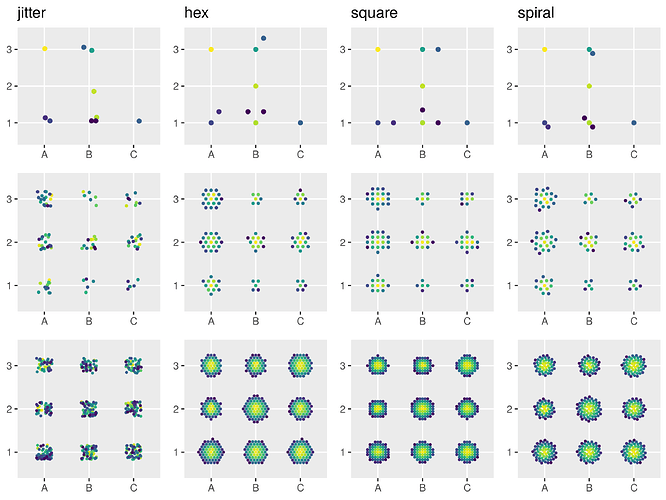Problem
Plotting data with 2 categorical variables, but I want to visualize all the data points for each unique combination of categories. Usually, people do something like:
g = ggplot(...) +
geom_point(
position = position_jitter(...)
)
but the result is a) ugly, and b) unreliable. I propose a solution:
Solution
Essentially it is a new "position" called position_bunch, which distributes the points at each unique (X,Y) according to a pattern. It can be used like:
g = ggplot(...) +
geom_point(
position = position_bunch(
shape = 'hex',
width = .7,
sort = TRUE,
)
)
yielding stuff like (jitter for comparison):
Implementation
position_bunch = function(shape='hex',width=0.5,sort=1) {
if (shape == 'hex') {
n.layer.fun = n.layer.hex
delta.fun = delta.hex
}
if (shape == 'square') {
n.layer.fun = n.layer.square
delta.fun = delta.square
}
if (shape == 'spiral') {
n.layer.fun = n.layer.spiral
delta.fun = delta.spiral
}
if (sort) {
sort.fun = sorting.fun
} else {
sort.fun = identity
}
cols = c('x','y')
return(ggproto('PositionBunch',Position,
required_aes = cols,
compute_layer = function(self,data,params,layout) {
select = function(x,y) {
return((data$x==x) & (data$y==y))
}
u = unique(data[,cols])
n = mapply(function(x,y) {sum(select(x,y))},u$x,u$y)
l.max = n.layer.fun(max(n))
delta = sort.fun(delta.fun(l.max),1)
for (i in 1:nrow(u)) {
rows = select(u$x[i],u$y[i])
delta.i = sort.fun(delta[1:sum(rows),cols],sort) * (width/2/l.max)
data[rows,cols] = data[rows,cols] + delta.i
}
return(data)
})
)
}
sorting.fun = function(delta,dir) {
distance = apply(delta,1,function(d){sum(d^2)})
return(delta[order(distance,decreasing=(dir==-1)),])
}
# -----------------------------------------------------------------------------
# hex
n.layer.hex = function(n) {
return(floor(1+(-3+sqrt(9+12*(n-1)))/6))
}
delta.hex = function(layers) {
yv = sqrt(3)/2; yh = 0; xv = 0.5; xh = 1;
rep.steps = function(steps,layer,dim) {
steps = rep(steps,each=layer)
steps[1] = steps[1] + xv*(dim=='x') - yv*(dim=='y')
return(steps)
}
dx = 0; dy = 0;
for (layer in 1:layers) {
dx = c(dx,rep.steps(c(+xv,-xv,-xh,-xv,+xv,+xh),layer,dim='x'))
dy = c(dy,rep.steps(c(+yv,+yv, yh,-yv,-yv, yh),layer,dim='y'))
}
return(data.frame(x=cumsum(dx),y=cumsum(dy)))
}
# -----------------------------------------------------------------------------
# square
n.layer.square = function(n) {
return(floor(1+(-2+sqrt(4+8*(n-1)))/4))
}
delta.square = function(layers) {
yv = 1; yh = 0; xv = 0; xh = 1;
rep.steps = function(steps,layer,dim) {
steps = rep(steps,each=2*layer)
steps[1] = steps[1] + xh*(dim=='x') - yv*(dim=='y')
return(steps)
}
dx = 0; dy = 0;
for (layer in 1:layers) {
dx = c(dx,rep.steps(c( xv,-xh, xv,+xh),layer,dim='x'))
dy = c(dy,rep.steps(c(+yv, yh,-yv, yh),layer,dim='y'))
}
return(data.frame(x=cumsum(dx),y=cumsum(dy)))
}
# -----------------------------------------------------------------------------
# spiral
f.spiral = pi*(1+sqrt(5))
n.layer.spiral = function(n) {
return(ceiling(n/f.spiral))
}
delta.spiral = function(layers){
i = 0:ceiling(layers*f.spiral)
r = layers/2*sqrt(i/layers)
t = pi*(1+sqrt(5))*i
dx = r * cos(t)
dy = r * sin(t)
return(data.frame(x=cumsum(dx),y=cumsum(dy)))
}
Test Code
library('ggplot2')
library('gridExtra')
library('viridis')
source('ggpositions.r')
set.seed(1234)
w = .7
g.list = list()
for (N in c(10,100,500)){
data = data.frame(
x = factor(floor(runif(N,1,3+1)),labels=c('A','B','C')),
y = factor(floor(runif(N,1,3+1))),
z = rev(sort(runif(N,1,N)))
)
for (shape in c('jitter','hex','square','spiral')){
if (shape == 'jitter'){
pos = position_jitter(width=w/4,height=w/4)
} else {
pos = position_bunch(
shape = shape,
width = w,
)
}
g = ggplot(data,aes(x=x,y=y,color=z)) +
geom_point(position=pos,size=sqrt(2)/log10(N)) +
scale_color_viridis() +
xlab(NULL) + ylab(NULL) +
theme(legend.position='none')
if (N==10){ g = g + ggtitle(shape) }
g.list[[length(g.list)+1]] = g
}
}
G = do.call(arrangeGrob,c(g.list,list(nrow=3)))
ggsave('test.png',G,width=8,height=6)
Notes
-
It's a work in progress, so feedback welcome! What do you think?
-
I've only tested it with
geom_pointusingaes(x= ,y= )so far -
Point sizes are hard to scale reliably, so you may have to tinker manually
-
After cleaning & testing, I plan to upload to the ggplot2 extensions library
